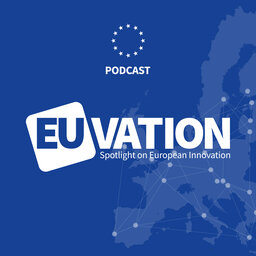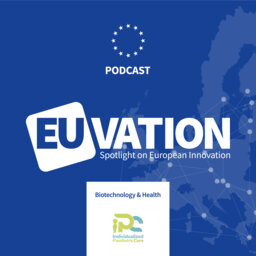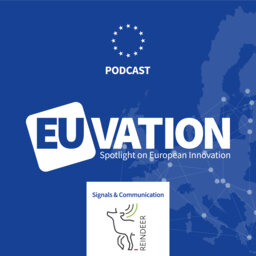iPC (3) H2020 Project: How algorithms can improve treatment for children with cancer
In this episode we talk with Pieter Mestdagh, principal investigator at the Cancer Research Insitute Ghent, who is a project partner in iPC.
He shares his teams methods with us for a better understanding of their motives and how algorithms can improve effective treatment for children with cancer.
The iPC project has received funding from the European Union’s Horizon 2020 research and innovation programme under grant agreement No. 826121.
This is a Technikon podcast.
Algorithms and looking for effective treatment for children with cancer at first, this seems like an odd pairing, but by the end of today's podcast, you might think a little differently. I'm Peter Balint from Technikon, and today we look again at the iPC 2020 European project. In this project, medical doctors, researchers and clinicians come together with computer scientists and experts in artificial intelligence to arrive at an answer to one simple question How can we assign treatment plans to children with cancer without causing harm or major side effects? And this is where algorithms and artificial intelligence come in. Today from the iPC project, we speak with Pieter Mestdagh , principal investigator at the Cancer Research Institute Ghent. He is a project partner in iPC, and he shares his team's methods with us for a better understanding of their motives. Let's have a listen. Welcome to the podcast, Pieter. Thanks for coming on.
You're welcome.
You are using an efficient method called computational deconvolution to understand the different cell types in a tumour sample in order to predict response to immunotherapy. This could quickly become a complex conversation, but I'd like you to tell us what this means in simple terms.
Sure. So I think the first thing you need to realize is that a tumour tissue or any tissue, for that matter. So tumour tissue does not only consist of tumour cells. So these tissues are very heterogeneous. They're a heterogeneous mixture of various different cell types, including tumour cells, but also, for instance, immune cells. And on top of that. Even a tumour cell within a tumour tissue is not identical or identical to other tumor cells in that tissue. And so some tumour cells may, for instance, be more resistant to certain therapies while others are not. So that's that's a key thing to understand before we can move on to explaining what computational deconvolution actually is. So if we can understand the cellular composition of a tumour tissue, we could potentially make predictions on the course of the disease and the prognosis of the patient, even the response to certain therapies. We know, for instance, that the presence of certain immune cell types within the tumour tissue is associated to response to immunotherapy, for instance. Now, to determine the cellular composition of a tumour, there's various approaches and technologies that we can use and by far the most advanced technologies the technology that we refer to as single cell RNA sequencing. And so a single cell RNA sequencing allows you to quantify the gene expression profile of individual cells within a tissue, and such a gene expression profile can then be used to determine the type of cell the profile is derived from. So by performing single cell RNA sequencing, you can actually determine the cellular composition of of a of a tissue, for instance, a tumor tissue. Now the problem with this technology is that while it's for sure state of the art, it's still pretty expensive to date. You need to be able to quantify the gene expression profile of thousands of individual cells in the sample, and the setting, as it is today, is not really compatible with a clinical application yet. So what we are trying to do with computational deconvolution is to determine the fraction of individual cell types of different cell types in the tumour tissue using the gene expression profile from the entire tumor sample. Now, generating such a gene expression profile of a bulk tumor sample is especially compared to single cell RNA sequencing, relatively cheap and definitely compatible with what the clinical setting and clinical application. Now the challenge is how do you decompose the bulk signal coming from this entire tumour tissue into eventually what we need cell fractions and the algorithms that do that are commonly referred to as computational deconvolution algorithms. So what we are trying to do is to develop methods, computational deconvolution methods that can define individual cell fractions for different types of pediatric cancer tumour tissues.
OK, well, that's a lot to get a hold of, but I think that the clear message there might be that there's just not one single way to approach a treatment plan. It could be different in many different cases.
Yes, I think so. If you're referring to treatment as treatment of the patient and there's a lot of information that goes into the therapeutic decision making, and it's only very recently that we have started to understand. Well, first of all, the fact that the tumours are quite heterogeneous, that the tumour tissues are composed of other cell types, healthy cell types that can impact the wiring and the signaling within the tumour cells that can impact how tumours will respond to therapy or at least to certain therapies. So being able to quantify this information, being able to to to determine this, this composition can help in therapeutic decision making about this is, of course, very early days. These things are not routine clinical practice yet, as we are still starting to understand the association between, for instance, therapy response and a different cellular subtypes. And this is exactly what we want to do within iPC and then specifically focused on pediatric cancer types is to understand how heterogeneity cellular heterogeneity in composition within a tumour tissue is associated to the prognosis of the patient, the response of the patient to therapy.
OK, so tell us a little bit about your potential outcomes. I mean, I think these are comprised of algorithms. How are the results from iPC shared or applied for others in the future?
So the outcomes are indeed algorithms. I would even say validated algorithms. We're not just building algorithms, we are building algorithms to to apply to in certain settings and to validate that we can use them for the purpose that they were developed. So it will be validated algorithms. And this is done by integrating data from various resources data that we've collected from various sources that we use for for for validation of the methods that we develop. So this data, for instance, allows us to to evaluate performance with respect to say, for instance, patient prognosis or therapy response. And the end goal is to make, of course, these algorithms publicly available and we can do that through various routes. There's, of course, scientific publications, but also dedicated software repositories where the software that is being developed within the iPC, the algorithms that are developed will be made available. And I think this is especially important because it will allow others to not only apply the algorithms in other datasets, but also even modify or to optimize what we have built to make it more compatible, for instance, to use or to apply to other cancer types.
OK. When I look at other projects like this out there, perhaps other H2020 projects, research projects, they often have some sort of clinical trial attached. And if I understand this correctly in iPC, there is no clinical trial component, meaning that no tumour samples are collected. So then what then are you using to apply your algorithm to?
Well, indeed, we are not running clinical trials, is not an active component of of iPC, but of course there is a lot of data out there. A lot of genomics data transcriptomics data has been generated for different cancer types and basically for any any cancer type, data has been generated with respect to transcriptome and genome composition and mutations, fusion genes. So what have you? So what we're doing within iPC is is we've basically collected this has been one of the first steps was to collect the publicly available information that is out there, the thousands of profiles that have been published or publicly available for the scientific community to work with. This data has been collected and organized in such a way that we can now easily access it in a uniform way between the different partners within the iPC and use it to develop and build our algorithms. So we're basically making use of enormous amounts of publicly available data that has been generated over the years and trying to build and develop novel ways of looking and interpreting that data always ultimately with the aim to help the patient.
And yeah, it sounds like that's a highly effective approach, actually. I wonder, though, you are, according to the website, you are focusing on identifying effective, personalized medicine for pediatric cancers. And I wonder if your discoveries in iPC could serve a wider demographic at some point. I mean, the things that you're doing in iPC, could they sort of extend beyond the world of pediatrics?
Well, they may. So the algorithms that we are developing are not necessarily limited in application, at least to pediatric cancer types. I would definitely say that the concepts and the frameworks that underlie the algorithms that are being built within the iPC are definitely also relevant for older cancer types, both pediatric and adult. They may require a specific tweaking. They may require different input parameters, but they can definitely serve as a basis for other cancer types if, if properly validated, for sure. Actually, we're also within iPC actually also using data from adult cancer types to often to fill in blanks in the in the data that is available for pediatric cancer. Some of the data that is out there that we use within iPC is mainly focused on adult cancer types. But so we're also using information from adult cancer types to to to build and improve our pediatric cancer models. So for sure, there will definitely be applications beyond the pediatric cancer types and the frameworks that we're building are wildly applicable, of course.
So the work that you're doing could continue on for a long, long time actually with these, with the algorithms that you're working on.
Well, indeed. So I think what we are specifically focusing now on this is, of course, pediatric cancer. But once you have a framework that appears to be very efficient in doing what you wanted to do in our case, computational deconvolution, we can leverage that information and train the models to also work for other cancer types. Other adult cancer types. We're generating knowledge on the composition of the tumour tissue has relevant applications towards clinical decision making, therapy, response predictions and so on.
Okay. And let's take a look at the pragmatic effects of the COVID pandemic. How how has this affected your work in iPC because the pandemic came, you know, sort of when you were in the middle of all of this. So how was that for you?
Well, I think to some extent within within the iPC and the work that we put forward when writing this and scoping this project, we were a bit lucky not to be affected too much. As most of the work within the iPC is really focused on data analysis, not on data generation. So we have still been able, in contrast to many others, unfortunately, to continue at least a big part of the work. But of course, there have been delays. There is also an experimental part, experimental work packages that require wet lab work and require really experimentation in the lab. That, of course, were were delayed because of the pandemic. But. I would say, compared to probably a lot of other research projects iPC is mainly focused on data analysis and for data analysis, you basically need the computing infrastructure but no access to to a wet lab.
So the impact could have been a lot worse if if the focus was more on the wet lab, our data generation kind of area.
Oh yes, for sure.
What about other challenges from your site or from your team at the university? What kind of challenges did you face other than the COVID situation?
Well, there's there's always technical challenges, of course, and methodological challenges when you're developing new ways, new methods, new procedures to try to address certain certain questions. I think one, this is very specific for our case. So building these computational deconvolution methods, we we actually need to validate our methods to validate that they work properly. That they do a good job in predicting the cellular composition of a tumour sample. We actually first need to define the ground truth. So what is the true composition of cells in the tumor tissue? And so the ground truth can, can, can be derived from, of course, single cell RNA sequencing data, which is a technology I referred to earlier, a state of the art technology that really allows you to determine the identity of individual cell types within a tissue with pretty high precision and accuracy. But of course, there's not that many data sets out there. So we've been able, luckily within iPC to collect several single cell RNA sequencing datasets for a large number of pediatric cancer datasets, the cancer cases cancer types but the challenge is then again, to try to understand whether they really captured the full spectrum of cellular heterogeneity for each of these cancer types or not. And to try to take that into account when developing people or methods. So so this very specific set of challenge is one that we are facing in the analysis that we are doing within iPC .
And finally, let's take a look at this iPC project from the aspect of the individual level. So, you know, how could what you're doing have an effect on some person or, you know, just maybe even on a societal level? Science aside.
So I think we're all convinced that there is a need for better treatments for cancer patients in general and especially definitely for a lot of pediatric cancer cases. So the ultimate goal of iPC is really to develop new tools that we can use to improve the survival of pediatric cancer patients. That's the ultimate goal. And that actually means, you know, being able to develop more effective treatments that are less toxic for the patient to really administer to the right patients. If we can develop models that can support us in doing that, then I think we've achieved a major goal of iPC. I would say that today it's probably a bit too early to evaluate the level of progress that the iPC will eventually make with respect to these goals, especially because you can develop methods based on the data that is out there. But ultimately what we do will require a prospective validation in the clinic to really prove that that we are improving the outcome survival of pediatric cancer patients. But we're hopeful and enthusiastic that we'll be able to do that, of course.
So when it comes to looking at it from this perspective of the individual or society, we're still relatively early.
Yes. And I think that's that's not because we are slow at iPC. That's just because how this type of research requires time and to be able to translate it properly to the clinic, we can develop methods based on the data that is availabe, again, but ultimately, we need to do prospective validations in clinical trials to validate the methods or the new treatments that we put forward and to really demonstrate in an actual clinical setting that what we predict to improve the life expectancy of a patient will actually do that in a real large setting. And these things, these type of studies, of course, require time. This is not something you do overnight or even in a few weeks or months or so. These things take time, and I think that's why it's it's too early today to really evaluate ultimately how large the impact of iPC will be on this specific aspect, which is, again, improving the survival of pediatric cancer patients.
Hmm. Well, this is very important work and we're really happy to have been able to spend a little bit of time to talk about it and to find out how it affects not just the scientific community, but everyone and especially those who might be suffering with a family member with cancer. So thanks for your contribution in the project and thank you also for explaining a little bit today. We really appreciate that.
Thank you.
For more information about iPC, go to ipc-project.eu . The iPC project has received funding from the European Union's Horizon 2020 Research and Innovation Program under grant agreement number 826121 .
 EUVATION: Spotlight on European Innovation
EUVATION: Spotlight on European Innovation


